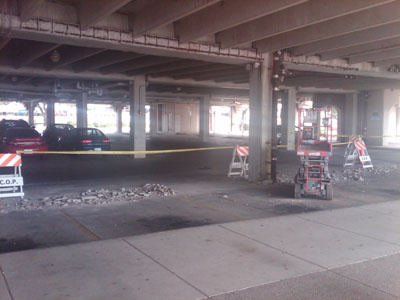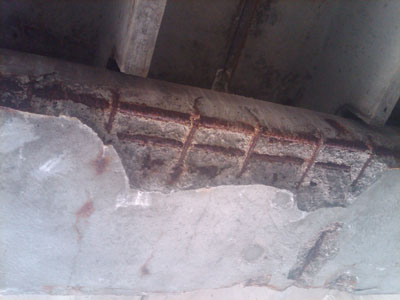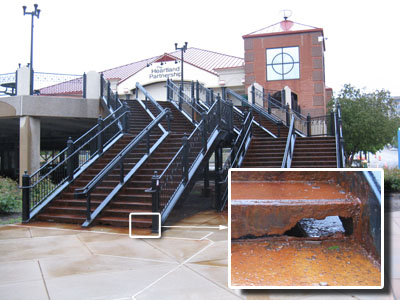In June 2010, the City Council voted to replace the steps up to the Riverfront Village platform because they were all rusted out. That was blamed on the salt used to melt ice on the steps in the winter, and the basic design of the steps which apparently had insufficient drainage. Now it’s the concrete platform itself that’s falling apart — literally:


Hard to blame this on ice-melt, since, to my knowledge, the City isn’t salting the underside of the platform in the winter. This week’s Issues Update gives some more detail:
A portion of concrete fell from the ceiling of the parking deck about two weeks ago onto a car causing minor damage to the vehicle. National Garages was contacted and advised staff of this incident. In response, staff decided to check the other areas of the garage and have determined there were sections of loose concrete that could potentially separate from the structure and could fall. Currently, staff is removing loose concrete to avoid future incidents. As these areas are exposed, we will engage a structural engineer to review the work. We will also be working to remove some of the rust from the steel and repaint. Sealing these areas with new concrete is not yet planned as we need to determine the full scope and find a contractor to perform this work. We will most likely need to bring this forward to City Council as the costs will exceed $10,000.
Riverfront Village is twelve years old. Twelve years old and already falling apart. This has to be an embarrassment to the contractor/sub-contractor responsible for building this platform. It should be, anyway. Hopefully the City will take the time to look up who did the work originally and at least make sure they don’t hire the same company to fix it.
Best-case scenario: the structural engineer finds that the whole structure is unsound and must be razed. No offense to the tax-paying businesses on the platform; I’d like to see them stay in business downtown. But the platform never should have been built, and the riverfront would be better off without it. There are plenty of places nearby for the restaurants to relocate . . . like the retail space promised on Water Street by the new museum. If you find your home having damage like this and need help with claims, talk to experts like LMR Public Adjusters and get help.

 The Riverfront Village platform was built in 1999 at a cost of roughly $9.5 million — $4.5 million of which was public tax money that won’t be paid off until 2018.
The Riverfront Village platform was built in 1999 at a cost of roughly $9.5 million — $4.5 million of which was public tax money that won’t be paid off until 2018.